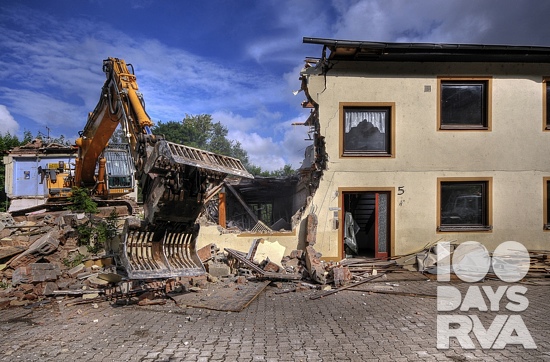Day #015: Stop building futon buildings
What are we doing to encourage development worthy of future generations?

Inspired by Michael Bierut’s 100 Day Project, 100 Days to a Better RVA strives to introduce and investigate unique ideas to improving the city of Richmond. View the entire project here and the intro here.
- Idea: Include building lifespans in property appraisals, develop a private sector of housing recycling, relax certain zoning/codes, and stop limitlessly expanding roads and sewers. Allow for two distinct forms of development.
- Difficulty: 5 — Politicians struggle to think beyond terms, businesses struggle to think beyond the fiscal year, homeowners struggle to think beyond mortgages, and generations struggle to think beyond their children.
The landscape of Richmond has been built with a bizarre combination of century-old buildings that will be here for another 100 years1 and more recent buildings that don’t seem prepared to stand the test of time.
I’m not an engineer. I couldn’t tell you which buildings are physically sound, but there are reasons this type of development is taking place–and the differences are apparent to the naked eye. Richmond should at least acknowledge these issues and recognize that they stand in the way of building a town with infrastructure worthy of tourism, business, and beauty for the next 100 years.
The design of American cities fundamentally changed in the aftermath of World War II. After the end of the war (and the Great Depression), homeownership exploded because of easier financing, favorable tax laws, and the automobile. Suddenly everyone wanted a standalone home with a white picket fence in the chosen quarter. This gave rise to big box retail with surface parking out front.
As stores departed Main Street, retailers like Walmart reinvented the brick and mortar. In this amazing Econ Talk, Charles Morahn tells a story of Walmart accountants complaining about appraisers overcharging them for their buildings because they are designed to only last fifteen years–then they abandon ship and move somewhere else.
Property taxes are partially to blame. Appraisals have more to do with markets than property. People who make significant investments for the longterm can quickly get priced out of their own neighborhood if it improves.
Zoning is also pesky. It limits the type of repurposing that could create low impact short-term development.
The largest problem is transportation infrastructure. As a metropolitan area, we have repeatedly allowed development to happen in forests on the fringe at great expense to taxpayers while entire neighborhoods full of 30 year infrastructure lay rotting.
Today’s idea originally started out as finding ways to increase building lifespans, but Marohn opened my eyes to something different.
Most development in Richmond during the last 30 years isn’t “throwaway” but it won’t endure more than a generation. New buildings are basically futons (bad couches + bad sofas) or El Caminos (everything bad in a car + everything bad in a truck). They strike an unfortunate balance between being cheap enough to afford and being worth the maximum amount after a 30-year mortgage before falling to pieces or requiring significant repairs.
A much better model would be cheap, LEED-certified buildings that can be easily torn down and recycled after ten to thirty years and infrastructure meant to last as long as buildings in cities like Prague.
Property taxes should take building lifespans into consideration. “Throwaway” buildings should be encouraged if made with sustainability in mind: the restaurant made of old shipping containers is different than a big box retailer. One can be entirely repurposed, the other has four acres of surface parking out front. The latter taxes the city’s sewer system, is aesthetically unappealing, and sends quarts of oil into Chesapeake Bay’s watershed.
Zoning and incentives should also push these two different types of development. Finally, the government needs to stop blindly laying new roads, sewers, and power lines for new development while plenty of buildings and areas lay in disuse. Sprawl and the suburbs are fine, but businesses are never going to make longterm investments if they can build new buildings further out every 15 years without paying for new city infrastructure.
Through private and public actions, it’s time to change our patterns of development so they are worthy of future generations.
Love this idea? Think it’s terrible? Have one that’s ten times better? Head over to the 100 Days to a Better RVA Facebook page and join in the conversation.
Photo by: Wolfgang Staudt
- Survivorship bias is a concern, but a simple survey of The Fan shows just how many buildings are 100+ years old. ↩
-
Recommend this
on Facebook -

Report an error
-

Subscribe to our
Weekly Digest





Notice: Comments that are not conducive to an interesting and thoughtful conversation may be removed at the editor’s discretion.